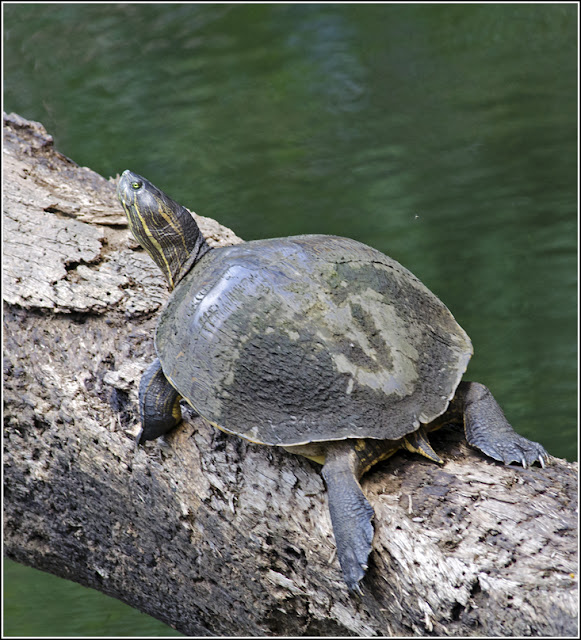----------------------------------------------------
Steve, Andrew and I birded the Parque Natural Metropolitano for a few hours in the morning - the last of our Panamanian adventure. We were hoping to add a few final target species at the park, such as Yellow-green Tyrannulet, one of about 12 bird species that are endemic to Panama.Steve only had a short time in the park before he had to leave for the airport, while Andrew and I birded the park until 9:30 AM.
The 265 acre park is an oasis within an urban area; not only popular with dog-walkers, runners and cyclists but also birders. It consists predominately of lowland deciduous forest and boasts a huge species total (the eBird hotspot for the park has 373 species).
Our time here was relatively birdy, and highlights among our 71 species included several Rosy Thrush-Tanagers, Pale-eyed Pygmy-Tyrant, Olivaceous Woodcreeper (a new one for me), my long-overdue lifer White-lined Tanager, and the big highlight: a Yellow-green Tyrannulet providing excellent looks for Andrew and I on a bare branch right above the trail.
 |
| Crimson-crested Woodpecker - Parque Natural Metropolitano, Panama City |
 |
| Crimson-crested Woodpecker - Parque Natural Metropolitano, Panama City |
Whooping Motmots are not necessarily a shy species, but they rarely forage on the ground only a few feet away from people. This individual must have been much more acclimated to human presence since it did not seem to mind the people walking past.
 |
| Whooping Motmot - Parque Natural Metropolitano, Panama City |
 |
| Whooping Motmot - Parque Natural Metropolitano, Panama City |
 |
| Whooping Motmot - Parque Natural Metropolitano, Panama City |
This Squirrel Cuckoo was also providing rare, unobstructed views.
 |
| Squirrel Cuckoo - Parque Natural Metropolitano, Panama City |
My flight did not depart until early in the evening meaning I had all day to join Andrew in doing some birding. We made the decision to head back to Old Gamboa Road where we would meet up with Jenn for a few hours.
It was quite warm during our late morning excursion here, putting a damper on bird activity. I was happy to add Tawny-crowned Greenlet to the list, along with a wide variety of species that we had observed earlier in the trip at Old Gamboa Road.
Jenn knew the location where a Spectacled Owl roosted, and it only took u a minute or so of searching until it appeared. Awesome!!
 |
| Spectacled Owl - Old Gamboa Road, Panama |
The three of us were pretty hungry after the morning of birding so off we went to a pizza place in the town of Clayton that Jenn recommended. A very tame Fork-tailed Flycatcher was hanging around the parking lot - with the hot temperatures, it was keeping its mouth open as a sort of air-conditioning! It was here I also added my last new bird of the trip - an introduced Saffron Finch on the grass beside the parking lot.
 |
| Fork-tailed Flycatcher - Clayton, Panama |
Andrew and I said our goodbyes to Jenn, then debated where we should spend the rest of the afternoon. There really wasn't a whole lot that I still needed from the Canal Zone, plus the hot temperatures had undoubtedly put a damper on the bird activity. We decided to drive over to Costa del Este to scan the shorebirds and gulls once more.
It was here that I began to experience quite a bit of discomfort that came on suddenly and I ended up spending more time crouched in the mangroves than actually scanning the birds. This was the first time I had ever experienced some sort of illness while traveling, but fortunately I was well-stocked with Imodium. I don't recall much in the way of bird sightings that afternoon but there wasn't much of anything that was new I don't think. Andrew was kind enough to drop me off at the airport later that afternoon and luckily the Imodium had begun to kick in, preventing what would otherwise be a very uncomfortable international flight!
It had been a wildly successful trip to central and eastern Panama with good friends. We found almost 500 bird species in 17 days, while also experiencing a range of other wildlife sightings, visiting some unique and beautiful areas, and experiencing Panamanian hospitality. It is certainly a country I will visit again in the future sometime - the western mountains and Azuero Peninsula in particular are places I would love to explore.
Total bird species: 496
















































